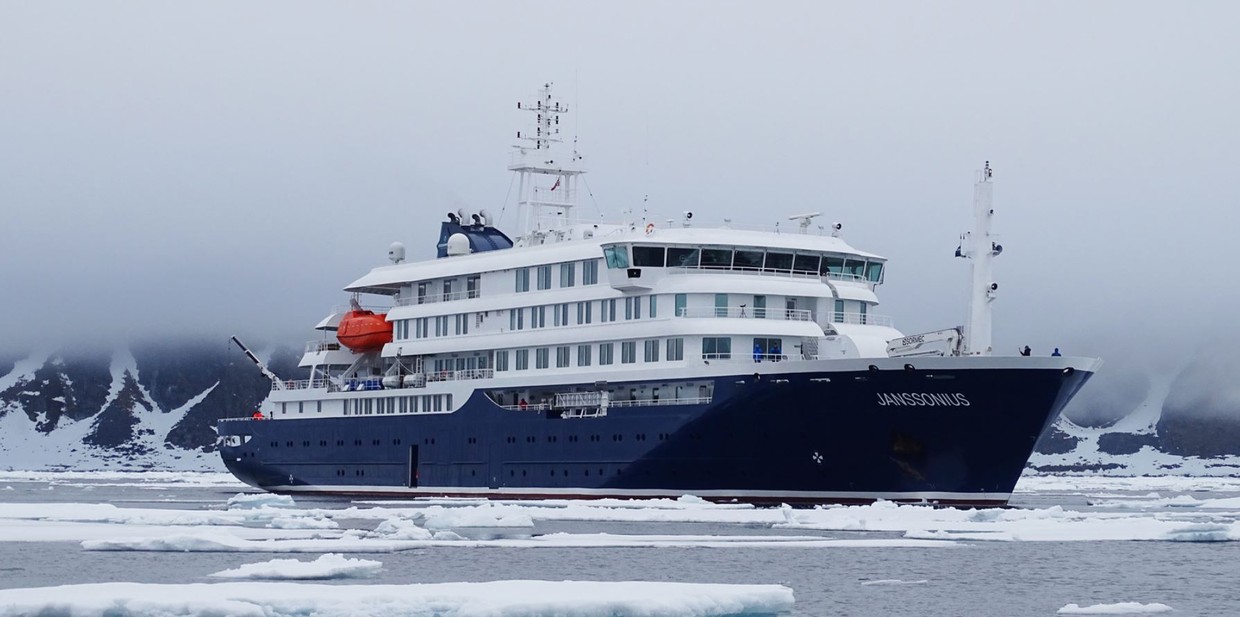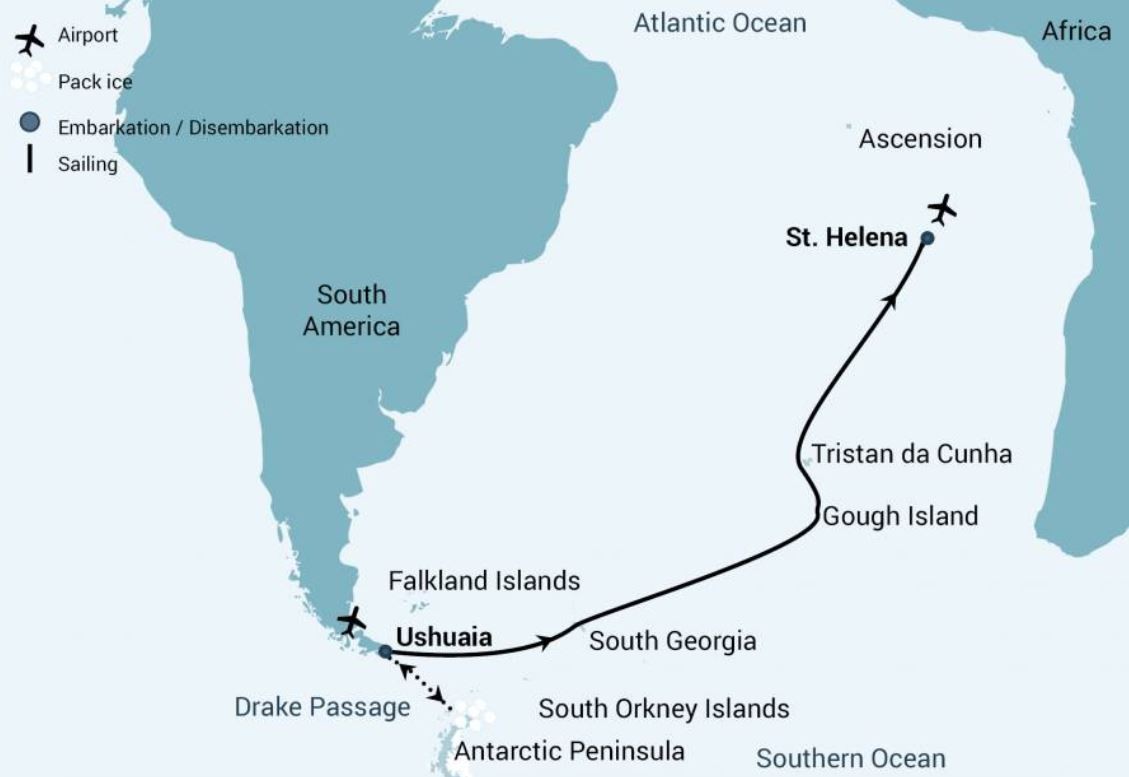from$ 20139 AUD
Note: Current p/p indicative rate. Final price may change due to currency fluctuations.
Janssonius
Ushuaia to St. Helena
Overview
The Atlantic Odyssey is a bird-watcher’s delight as we cross paths with the migratory routes of species such as the Artic Tern & the Long-tailed Skua. We visit some of the most remote islands in the world while crossing the Atlantic and the Equator.
Departures
Cruise Itinerary
Your voyage begins where the world drops off: Ushuaia, Argentina, reputed to be the southernmost city on the planet, located on the far southern tip of South America. Starting in the afternoon, you embark from this small resort town on Tierra del Fuego – nicknamed “The End of the World” – and sail the scenic, mountain-fringed Beagle Channel for the rest of the evening.
Over the next two days on the Drake Passage, you catch a taste of life from the perspective of the polar explorers who first braved these regions: cool salt breezes, rolling waves, maybe even a fin whale blasting up a column of sea spray. After passing the Antarctic Convergence – Antarctica’s natural boundary, formed when north-flowing cold waters collide with warmer subantarctic seas – you are in the circum-Antarctic upwelling zone. Not only does the marine life change, the avian life changes too: A variety of albatrosses and petrels show up, along with Cape pigeons and southern fulmars. Then, near the South Shetlands Islands, the first icebergs flash into sight.
Gray stone peaks sketched with snow, towers of broken blue-white ice, and dramatically different wildlife below and above. You first pass the snow-capped Melchior Islands and Schollaert Channel, sailing between Brabant and Anvers Islands. Possible sites you may visit include: Wilhelmina Bay – A likely spot to see feeding humpback whales. If conditions allow, you may even embark on a Zodiac cruise to the ghostly wreck of the Guvernøren, a whaling vessel that caught fire here in 1915. Cuverville Island – Stabbing up between Rongé Island and the Antarctic Peninsula, Cuverville houses a colony of several thousand gentoo penguins as well as pairs of breeding brown skuas. Danco Island – Activities here may focus on the gentoo penguins nesting on the island, in addition to the Weddell and crabeater seals that may be found nearby. Neko Harbour – An epic landscape of mammoth glaciers and endless wind-carved snow, Neko Harbour offers opportunities for a Zodiac cruise and landing that afford the closest views of the surrounding alpine peaks. Paradise Bay – You may be able to take a Zodiac cruise in these sprawling, ice-flecked waters, where you have a good chance of seeing humpback and minke whales. You have the chance to land on the Continent here too. Booth, Pléneau & Petermann Islands – You may sail through the Lemaire Channel in search of Adélie penguins and blue-eyed shags. There’s also a good chance you’ll encounter leopard seals as well as humpback, minke, and fin whales here. You may also visit Booth Island’s Port Charcot. Melchior Islands – A beautiful landscape rich with icebergs. Leopard seals, crabeater seals, and whales are found here, and there are excellent opportunities for kayaking and diving. You depart at noon, depending on conditions on the Drake Passage.
While crossing the Drake, you’re again greeted by the vast array of seabirds remembered from the passage south. But they seem a little more familiar to you now, and you to them.
New passengers join you in Ushuaia before you push back through the Beagle Channel.
A number of albatross and petrel species follow your vessel eastward across the Antarctic upwelling zone toward South Georgia.
The plan is to visit some of the world’s top king penguin rookeries. This time of year you have a good chance of seeing these animals nesting on eggs, their chicks close by. The rookeries are overflowing, with waddling rush-hour traffic to and from the beach. Possible visits include: Salisbury Plain, St. Andrews Bay, Gold Harbour – Here you see not only the massive king penguin colony, but also elephant seals and limitless fur seal pups playing in the surf. Prion Island – This location is closed during the early part of the wandering albatross breeding season (November 20 – January 7). From January on, the breeding adults have found their partners and are sitting on eggs or nursing their chicks. Enjoy witnessing the gentle nature of these animals, which possess the largest wingspan of any birds in the world. Grytviken – You have the opportunity to check out this abandoned whaling station, where king penguins now walk the streets and elephant seals lie around like they own the place – because they just about do. You might also see the South Georgia Museum as well as Shackleton’s grave. Cooper Bay – A great place for a Zodiac cruise, this bay also houses a rookery of macaroni penguins. King penguins, pintails, and giant petrels may also appear here.
A pleasant tailwind often accompanies the vessel through the westerlies, and on both sides of the Convergence fly vast numbers of Antarctic and Subantarctic seabirds.
You first approach Gough Island for a Zodiac cruise in Quest Bay, weather permitting. Northern rockhopper penguins and Subantarctic fur seals are often seen here. In previous years it has been possible for the vessel to circumnavigate all but four miles of the 33-mile circumference of the island, taking in the scenery and unrivalled abundance of wildlife.
These islands are famed for their bird population, which includes rockhopper penguins, several species of albatross, petrels, skuas, terns, and many others. Your aim is to visit the settlement on the west side of this archipelago’s main island but the planned four days here may also allow us to land in Seal Bay on the south side or possibly at Sandy Point on the east side of Tristan da Cunha. Here we may encounter wildlife such as Yellow-nosed albatrosses and Sub-Antarctic fur seals and otherwise explore a very rarely visited spot. We aim to land at Nightingale and Inaccessible islands, with views of seabirds ranging from yellow-nosed albatrosses to brown noddies. Two day is reserved in case of bad weather, but please remember that nature determines the itinerary here: Since beginning the Atlantic Odyssey cruise in 1998, adverse weather led to the cancellation of 35% of Tristan da Cunha landings. It is not impossible, but it is difficult.
Seabirds and dolphins indigenous to this region often follow the vessel.
After landing at Jamestown, you have many opportunities to enjoy the local culture, pleasant climate, and endemic birds of this remote island. One such activity is a visit to Longwood House, where Napoleon died in exile. You also have the chance to explore the island on your own – and snorkel the shallows, seeing multitudes of tropical and subtropical fish. Disembarkation and a flight to Europe is possible from here. In the evening, the vessel departs for Ascension Island and Praia, Cape Verde where you may also disembark.
All itineraries are for guidance only. Programs may vary depending on local ice and weather conditions and in order to take advantage of opportunities to see wildlife. The on-board expedition leader determines the final itinerary. Itineraries may mention places that require permission to land, which must be granted by the relevant national authorities. Such permission is not granted prior to the publishing of these itineraries. Flexibility is paramount for expedition cruises. The average cruising speed of m/v Janssonius 10.5 knots.
Janssonius

Vessel Type: Polar Class 6 Cruise Ship Length: 107.6 metres Passenger Capacity: 170 in 80 cabins Built: 2019/2020 Happier polar passengers, healthier polar environment Not only will the numerous amenities and on-board entertainments help make your Janssonius voyage truly memorable, this ship also gives you the peace of mind that comes with choosing one of the most environmentally friendly vessel on the polar seas. Janssonius uses LED lighting, steam heating, bio-degradable paints and lubricants, and state-of-the-art power management systems that keep fuel consumption and CO2 levels minimal. This means that when you sail aboard Janssonius, you get to enjoy the exotic landscapes and wildlife as much as possible while impacting them as little as possible. Hotel comfort, expedition class Janssonius offers high-quality accommodation for 170 passengers in six grand suites with balconies (27 square meters, 291 square feet), eight junior suites (19 to 20 square meters, 205 to 215 square feet), eight superior cabins (20 to 21 square meters, 215 to 226 square feet), 11 twin deluxe cabins, (19 to 21 square meters, 205 to 226 square feet), 14 twin window cabins (12 to 14 square meters, 129 to 151 square feet) as well as 27 twin porthole cabins, two triple porthole cabins, and four quadruple porthole cabins that vary in size from 12 to 18 square meters, or 129 to 194 square feet. The passenger capacity certificate for Janssonius is 196 persons. One deck consists of a large observation lounge and separate lecture room, which are reserved for a wide variety of interactive workshops, exhibitions, and performances particular to Janssonius. Though elegantly designed in stylish mid-century modern décor, this vessel holds true to Oceanwide’s distinctive cozy and informal atmosphere. Swift & safe ship-to-shore operations It is our philosophy to keep sea time short so that we can focus instead on fast, effective access to shore and near-shore activities. To give you the maximum contact with the nature and wildlife you traveled so far to see, we employ a tough fleet of rigid-hull inflatable Zodiac boats that guarantee swift and safe landing operations for the passengers. Janssonius has two separate gangways and a sheltered indoor Zodiac embarkation platform that can also be used for special outdoor activities, such as kayaking. The fast, flexible, friendly heart of the polar regions Our top priority is taking advantage of every wildlife and terrain opportunity as it occurs. To keep our itineraries flexible itineraries and our response time rapid, Janssonius is equipped with advanced stabilizers and two main engines capable of powering the vessel up to 15 knots. But Janssonius sacrifices no warmth to achieve its keen polar edge: You will have 72 crew and staff members (including expedition and hotel staff) at your service while on board, ensuring that what little time you do spend on the ship you will spend comfortably entertained.
Highlights
• Enter the Antarctic • Enjoy South Georgia Journey • Discover Tristan da Cunha • See St. Helena Highlights
Map



